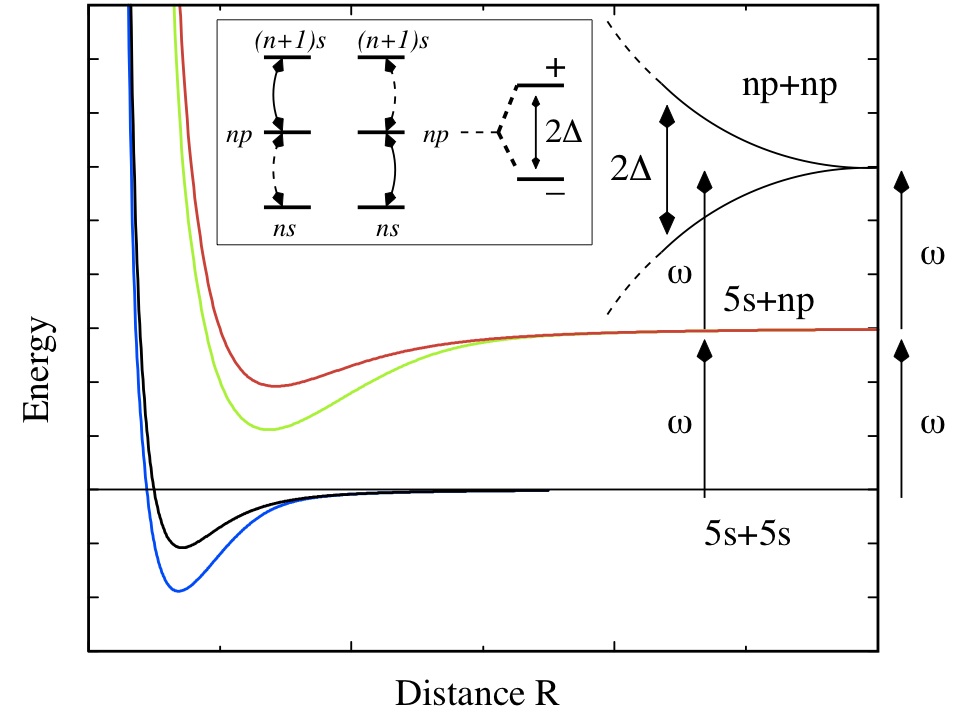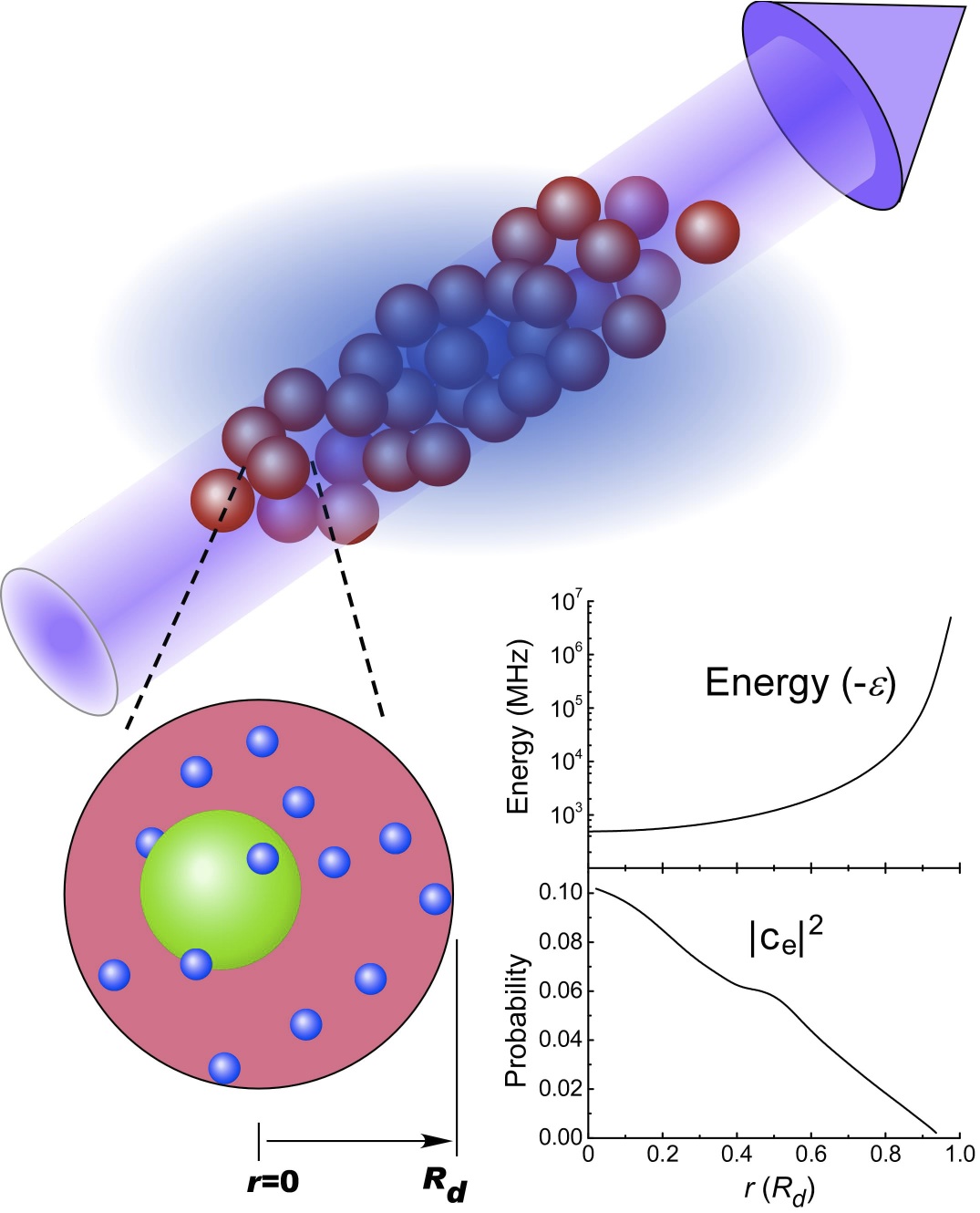The field of Rydberg physics has witnessed a revival in the last
decades, followed more recently by a rapid expansion into new
directions. A Rydberg atom is an atom excited into a high
energy level. Studies of Rydberg atoms have a long history, starting
over 80 years ago with investigations of pressure shifts and
broadening of Na and K Rydberg levels by rare gases. Their detection
in dilute interstellar region helped fuel the growing interest
in Rydberg physics. In such dilute environment, highly excited
atoms can live long enough to decay radiatively, and can be
sensitive to weak magnetic fields of a few μG and thus act
as magnetic probes of interstellar media.
 A Rydberg atom resembles a hydrogen atom, the effect of the
core electrons accounted for by the quantum defect
δ
For alkali atoms in a Rydberg state, the energy of the Rydberg
level described by the principal quantum number
n is given by
A Rydberg atom resembles a hydrogen atom, the effect of the
core electrons accounted for by the quantum defect
δ
For alkali atoms in a Rydberg state, the energy of the Rydberg
level described by the principal quantum number
n is given by
En
= I - Ry /
ν
2 where
ν = n - δ.
While the ionization potential
I
and the Rydberg constant Ry depend on the atom,
δ also
depend on the Rydberg level considered:
for example, for Rb,
I = 33,690.798
cm-1 and Ry = 109,736.605
cm-1,
while δ = 3.131
(ns
1/2),
2.655 (np
1/2),
2.641 (np
3/2),
and 1.347 (nd
3/2,5/2)
Rydberg atoms posses exaggerated properties which scale rapidly with the
principal quantum number n.
For example, their size and dipole moment scale as
n2,
while their polarizability and radiative lifetime scale as
n7
and n3,
respectively. Together with the small spacing between Rydberg levels
(scaling as n-3
), these lead to large interactions between Rydberg atoms,
scaling as n
4/
R3 and
n11
/R6
for dipole-dipole and van der Waals types, respectively.
In our group, we study the effect of these strong interactions on
the behavior of ultracold gases. For example, we predicted the
so-called blockade mechanism; in an ensemble containing
many atoms and under the right conditions, no more than one can
be excited into a Rydberg state. We identified two types of blockade,
namely the dipole blockade and the van der Waals (vdW) blockade.
The underlying principle of both mechanisms is the same; strong
Rydberg-Rydberg interactions shift the energy levels out of
resonance (see Fig. beside). So, one atom can be resonantly excited
into a Rydberg state, but additional Rydberg excitations are
prevented by the large shifts.
 The off-resonance condition depends on the laser bandwidth
γ,
and can serve to define a blockade or domain radius
Rd
(e.g., the smallest separation where the
double-excitation can still take place). If the Rydberg-Rydberg
interaction Δ shifts
the energy of a pair by more than γ,
atom pairs cannot be excited, and within this domain with
R<R
d, only one excitation can
occur. As shown in the sketch beside, a laser illuminating a
large atomic sample will generate several domains of radius
Rd
in which no more than one atom can be excited, and the number of
Rydberg excitations is therefore suppressed by the blockade mechanism.
Together with our UConn experimental collaborators, we have observed
and explained such phenomena. Because a Rydberg atom excited near the edge
of a domain has a larger probability of being closer to another Rydberg
atom in a neighboring domain, the Rydberg-Rydberg energy shift
ϵ
becomes larger near the edge, leading to a decreasing excitation probability
|ce|2.
We proposed to use the strong Rydberg-Rydberg interactions as well as
the blockade mechanism for quantum information processing
(see
Quantum Information Science for more details).
The off-resonance condition depends on the laser bandwidth
γ,
and can serve to define a blockade or domain radius
Rd
(e.g., the smallest separation where the
double-excitation can still take place). If the Rydberg-Rydberg
interaction Δ shifts
the energy of a pair by more than γ,
atom pairs cannot be excited, and within this domain with
R<R
d, only one excitation can
occur. As shown in the sketch beside, a laser illuminating a
large atomic sample will generate several domains of radius
Rd
in which no more than one atom can be excited, and the number of
Rydberg excitations is therefore suppressed by the blockade mechanism.
Together with our UConn experimental collaborators, we have observed
and explained such phenomena. Because a Rydberg atom excited near the edge
of a domain has a larger probability of being closer to another Rydberg
atom in a neighboring domain, the Rydberg-Rydberg energy shift
ϵ
becomes larger near the edge, leading to a decreasing excitation probability
|ce|2.
We proposed to use the strong Rydberg-Rydberg interactions as well as
the blockade mechanism for quantum information processing
(see
Quantum Information Science for more details).
The strong interactions between Rydberg atoms have other consequences.
In our group, we are also exploring how two Rydberg atoms could be
bound and form extremely large molecules. We predicted the existence
of molecules so extended (even in the μm range) that we call them
macrodimers. They have been observed experimentally first by the group
of Jim Shaffer at the University of Oklahoma. Since then, we have generalized
our treatment and predicted the existence of bound states of three Rydberg
atoms, now named macrotrimers.
Another interesting aspect of Rydberg physics is the possibility of
using a laser detuned far enough from the Rydberg level as to have
a very small probability of being excited. The state
|g⟩ of the ground state
atom is therefore dressed by the excited Rydberg state |r⟩, and can be
written as
|ψ⟩ = a|g⟩ + b|r⟩ ,
where |a|2 + |b|2
= 1, with |b|2= |Ω|2
/2Δ2. Here, Ω is the Rabi
frequency corresponding to the laser coupling between |g⟩ and |r⟩, and
Δ is the detuning from |r⟩.
We are exploring how a Rydberg-dressed atom interact with other atoms
or molecules.
For example, we showed that a Rydberg-dressed atom A approaching a
molecule BC could
be used to tune a chemical reaction: the little bit of Rydberg component
|b|2 increases the polarizability of the atom,
which in turn modifies the long-range van der Waals interaction between the
atom and the molecule. By carefully tuning the value of b, once can modify the
reaction rate A + BC → AB + C significantly.